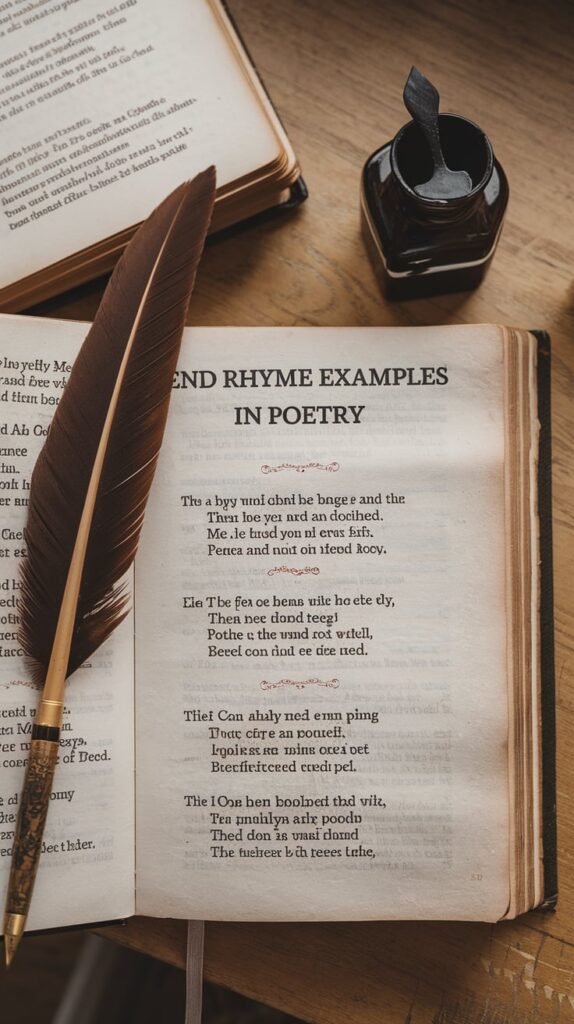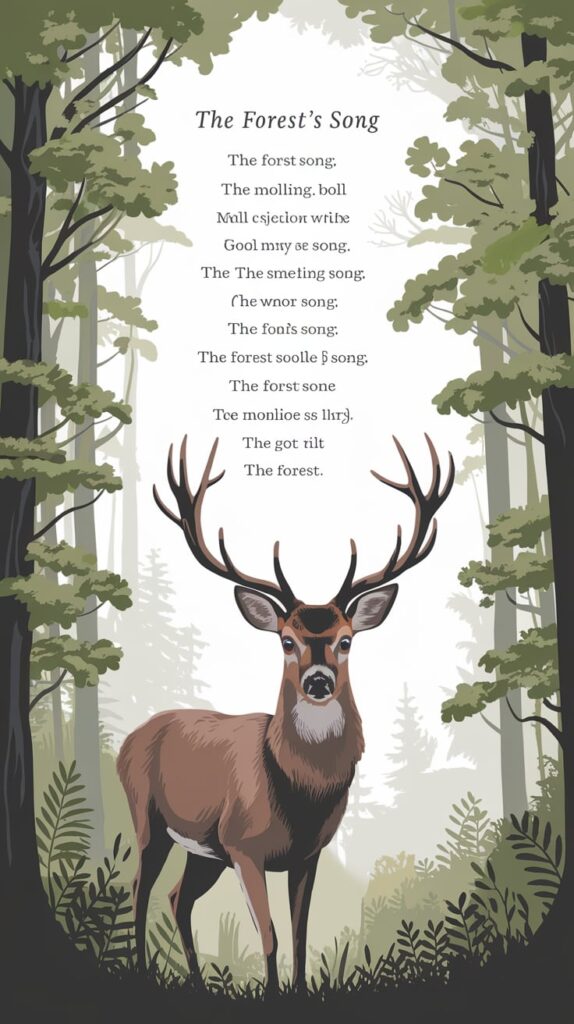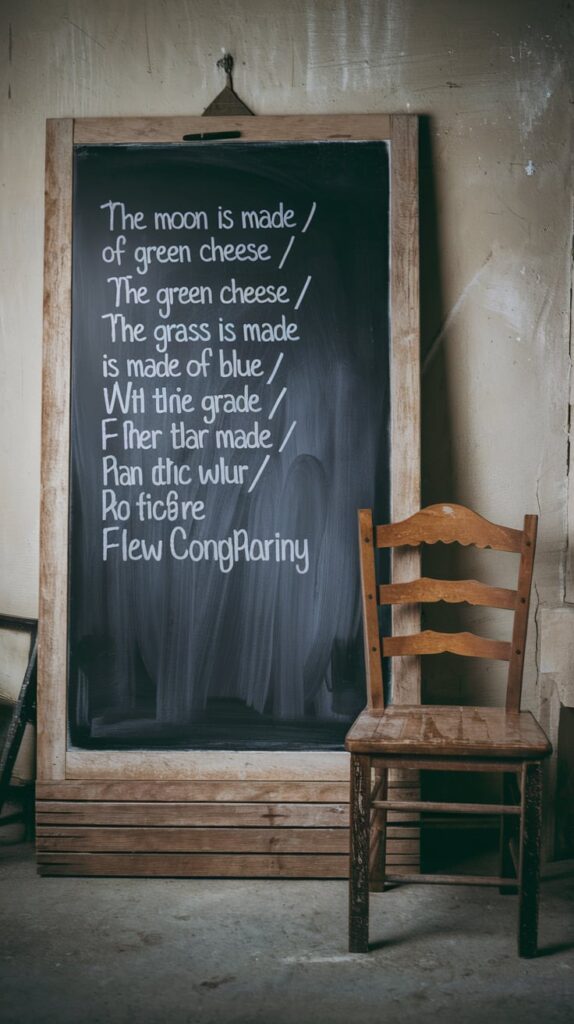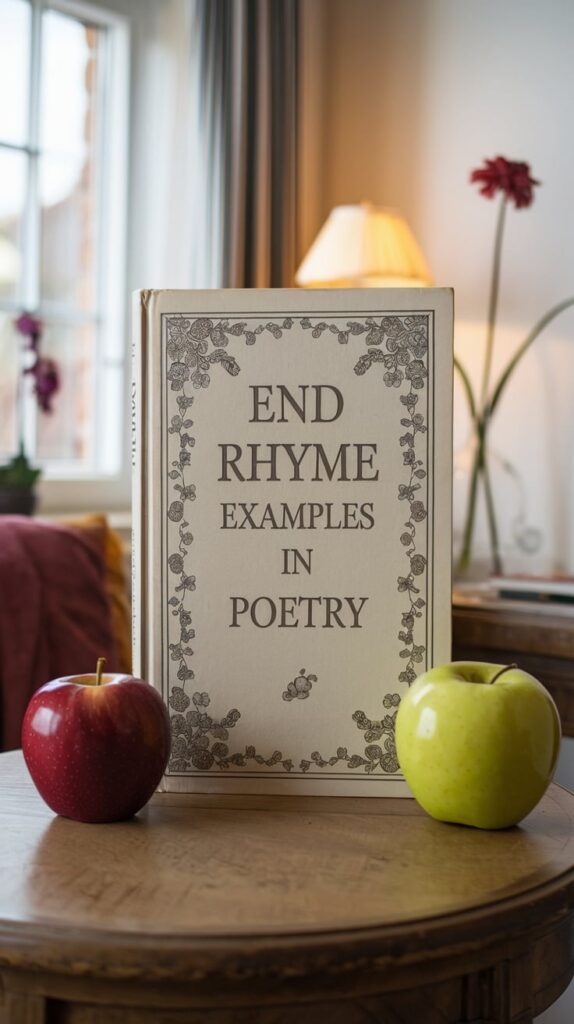Introduction to End Rhyme in Poetry
End rhyme stands as one of the most captivating elements in poetry, transforming simple words into harmonious expressions of emotion and imagery . In this article you will know about end rhyme examples in poetry.
When poets utilize end rhyme, they connect lines through similar sounds, creating a musical quality that resonates with readers. This article will delve deeply into end rhyme examples in poetry, exploring its functions, notable poems, and the intricate techniques that enhance poetic expression.
read more : Arised or Arose: What’s the Correct Past Tense of Arise? – Grammar Beacon
What is End Rhyme?
End rhyme examples in poetry occurs when the final words of two or more lines in a poem sound alike. This poetic device is foundational, creating patterns that enhance the rhythm and structure of a poem.
By pairing words at the end of lines, poets can evoke emotions, emphasize themes, and guide the reader’s experience.

Key Features of End Rhyme
- Musicality: The sound of rhymed words enhances the auditory appeal of poetry, making it pleasurable to read aloud.
- Rhythm: End rhyme contributes significantly to the poem’s rhythm, creating a pace that draws readers into its flow.
- Structure: The arrangement of rhyming lines can define the overall form of the poem, helping to organize thoughts and ideas.
Functions of End Rhyme in Poetry
End rhyme serves several critical functions in poetry, making it a vital component of poetic composition. Understanding these functions helps appreciate how poets craft their work.
Creates Rhythm and Musicality
End rhyme establishes a rhythmic pattern that not only sounds beautiful but also enhances the reading experience. The regularity of rhyme invites readers to engage with the text on an auditory level.
For instance, in nursery rhymes, the consistent end rhymes create a sense of predictability and enjoyment, making them memorable for children.
Emphasizes Ideas and Themes
By employing end rhyme, poets can draw attention to specific themes or ideas within their work. The repetition of sounds can highlight important messages and create a lasting impression on the reader.
For example, in “The Road Not Taken” by Robert Frost, the rhyme helps emphasize the poem’s exploration of choices and their consequences.
read more : Traveler or Traveller: Which Spelling is Right? – Grammar Beacon

Provides Structure and Form
Rhyme schemes give poetry a sense of order and structure. They guide the poet in organizing thoughts and creating a cohesive narrative. Common rhyme schemes include ABAB, AABB, and ABCB, among others
. Understanding these schemes allows readers to appreciate how structure impacts the overall experience of a poem.
Enhances Memorability
Poems with end rhyme are often easier to remember. The rhythmic quality of rhymed lines helps the audience recall the poem long after they’ve read it, which is particularly beneficial for oral traditions.
This memorability can transform a simple poem into a cultural artifact that resonates across generations.
Creates a Sense of Closure
End rhymes often provide a sense of completion, concluding thoughts and sentiments effectively. This closure can make the poem feel whole, guiding the reader towards a satisfying finish.
In sonnets, for example, the concluding couplet often delivers a powerful resolution or insight, encapsulating the poem’s essence.
read more : Plurals of ‘Ox’ and ‘Fox’ – Grammar Beacon

Aids in Creating Mood
The choice of rhyming words can evoke specific emotions, shaping the mood of the poem. Whether it’s a sense of joy, sadness, or nostalgia, end rhyme helps to cultivate the overall atmosphere.
In “Do Not Go Gentle into That Good Night” by Dylan Thomas, the end rhymes underscore the urgency and emotional intensity of the speaker’s plea.
Facilitates Flow and Pace
End rhyme can influence the pacing of a poem. Rhyming lines can create a quicker pace, inviting energetic reading, or slow it down for reflective contemplation.
This fluidity allows poets to manipulate the reading experience, making it more dynamic and engaging.
Notable End Rhyme Examples in Poetry
To illustrate the power of end rhyme, let’s explore notable examples from various poets. Each of these works demonstrates how end rhyme enhances the overall impact of the poem.
read more : The Past Tense of Meet – Grammar Beacon

“Ode to a Nightingale” by John Keats
John Keats’s “Ode to a Nightingale” is a prime example of how end rhyme enriches poetic expression. The poem reflects on beauty, mortality, and the transcendence of art.
Example Stanza
My heart aches, and a drowsy numbness pains
My sense, as though of hemlock I had drunk,
Or emptied some dull opiate to the drains
One minute past, and Lethe-wards had sunk:
Analysis
In this stanza, the end rhymes “pains,” “drunk,” “drains,” and “sunk” create a musical flow that echoes the poem’s contemplative tone. The repetition enhances the emotional weight of the lines, making Keats’s reflections more poignant.
“Stopping by Woods on a Snowy Evening” by Robert Frost
Robert Frost’s classic poem captures the beauty and stillness of a snowy evening, utilizing end rhyme to evoke serene imagery.
Example Stanza
Whose woods these are I think I know.
His house is in the village though;
He will not see me stopping here
To watch his woods fill up with snow.
Analysis
Here, the end rhymes “know,” “though,” “here,” and “snow” create a gentle rhythm that mirrors the tranquility of the scene. Frost’s use of end rhyme contributes to the poem’s meditative quality, inviting readers to share in the speaker’s moment of reflection.
“The Owl and the Pussycat” by Edward Lear
Edward Lear’s whimsical “The Owl and the Pussycat” showcases the playful side of end rhyme, engaging readers with its fanciful narrative.
Example Stanza
The Owl and the Pussycat went to sea
In a beautiful pea-green boat;
They took some honey, and plenty of money,
Wrapped up in a five-pound note.
Analysis
The light-hearted rhyme of “sea,” “boat,” “money,” and “note” adds to the poem’s charm and playful tone. Lear’s use of end rhyme invites readers into a whimsical world, making the poem delightful for all ages.
“I Wandered Lonely as a Cloud” by William Wordsworth
In this iconic poem, Wordsworth explores themes of nature and solitude, using end rhyme to enhance the poem’s lyrical quality.
Example Stanza
I wandered lonely as a cloud
That floats on high o’er vales and hills,
When all at once I saw a crowd,
A host, of golden daffodils;
Analysis
The end rhymes “cloud,” “hills,” “crowd,” and “daffodils” create a melodic flow that reflects the joy of the speaker’s encounter with nature. Wordsworth’s adept use of end rhyme enhances the poem’s emotional resonance.
“Sonnet 116” by William Shakespeare
Shakespeare’s “Sonnet 116” is a masterclass in the use of end rhyme, reinforcing its exploration of love’s enduring nature.
Example Lines
Let me not to the marriage of true minds
Admit impediments. Love is not love
Which alters when it alteration finds,
Or bends with the remover to remove:
Analysis
The ABAB rhyme scheme creates a harmonious flow, echoing the theme of steadfast love. The end rhymes underscore the sonnet’s argument, making it one of the most famous reflections on love in English literature.

Thematic Exploration of End Rhyme
Beyond its structural functions, end rhyme can significantly contribute to the thematic depth of a poem. By analyzing how end rhyme interacts with different themes, we can uncover richer meanings.
Love and Relationships
In poems focused on love, end rhyme can accentuate the emotional highs and lows experienced in relationships. For instance, in “How Do I Love Thee?” by Elizabeth Barrett Browning, the end rhymes enhance the poem’s romantic declarations, making each line resonate with passion and conviction.
Nature and Environment
Poets often use end rhyme to celebrate the beauty of nature, as seen in Wordsworth’s works. The harmonious sounds mirror the beauty of the natural world, inviting readers to connect deeply with their surroundings.
Mortality and Reflection
End rhyme frequently appears in poems addressing mortality, where the rhythmic patterns can heighten feelings of longing and nostalgia. In Keats’s “Ode to a Nightingale,” the end rhymes amplify the poet’s reflections on life and death, making the existential themes more poignant.
Whimsy and Playfulness
In contrast, whimsical poems like Lear’s embrace end rhyme to evoke a sense of joy and play. The rhymes create a light-hearted rhythm that enhances the fun and fantasy within the narrative, allowing readers to escape into a world of imagination.
Related Terms in Poetry
To fully appreciate end rhyme, it’s essential to understand related terms that enhance its use and significance.
Rhyme Scheme
The rhyme scheme is the pattern of end rhymes in a poem, described using alphabetic labels. For example, an ABAB scheme alternates rhymes, while an AABB scheme consists of consecutive rhymes
. Recognizing these patterns can enrich your understanding of how poets structure their work.
Common Rhyme Schemes
| Rhyme Scheme | Description | Example |
| AABB | Consecutive rhymes | Roses are red, Violets are blue, Sugar is sweet, And so are you. |
| ABAB | Alternating rhymes | Shall I compare thee to a summer’s day? Thou art more lovely and more temperate: |
| ABCB | Ballad form | There was a ship and she sailed the sea, And the name of the ship was the Billy O’ Tea. |
Internal Rhyme
Internal rhyme occurs when rhyming words appear within a single line, as opposed to at the end. This technique adds depth to the auditory experience and can enhance the poem’s rhythm.
For example, in a line like “I went to town to buy a gown,” “town” and “gown” create internal rhyme, enriching the poem’s texture.
Imagery
Imagery involves using vivid descriptive language that creates mental pictures. It often works in tandem with end rhyme to enhance emotional and visual appeal.
For instance, in Wordsworth’s poem, the imagery of “golden daffodils” complements the end rhyme, making the scene more vivid.
Poetic Devices
Various poetic devices such as alliteration, assonance, and metaphor often accompany end rhyme, enriching the poem’s texture. These devices contribute to the overall sound and meaning, creating a multifaceted reading experience.
- Alliteration: The repetition of consonant sounds at the beginning of words, as in “Whispering winds.”
- Assonance: The repetition of vowel sounds within lines, enhancing musicality, as in “The light of the night.”
- Metaphor: A figure of speech that compares two unrelated things, adding depth to themes and ideas.
The Impact of End Rhyme on Reader Engagement
Understanding end rhyme extends beyond technical appreciation; it significantly impacts how readers engage with poetry.
Emotional Connection
End rhyme fosters an emotional connection between the poem and its readers. The rhythmic quality often evokes specific feelings, whether joy, sadness, or nostalgia.
This emotional resonance enhances the reader’s investment in the poem’s themes.
Oral Tradition
In oral traditions, end rhyme plays a crucial role in memorization and transmission. The musical quality of rhymed poetry makes it easier to remember, allowing stories and messages to be passed down through generations.
This practice has been fundamental in many cultures, emphasizing the significance of poetry in communal storytelling.
Accessibility
End rhyme can make poetry more accessible, particularly for younger audiences or those new to poetry. The predictable patterns and musicality invite engagement, making poetry approachable and enjoyable.
This accessibility has encouraged the appreciation of poetry in diverse settings, from classrooms to public readings.
Conclusion
End rhyme is a powerful tool that poets use to enhance their work’s musicality, emotional resonance, and memorability. By exploring various examples, we see how this technique shapes a poem’s rhythm and structure, guiding readers through rich landscapes of thought and feeling.
From Keats to Frost, the art of end rhyme remains a vital component of poetic expression.
Through this exploration of end rhyme examples in poetry, we uncover not just a technique but a bridge that connects the poet’s emotions with the reader’s experience.
Whether through reflective musings or playful narratives, end rhyme invites us to engage deeply with the beauty of language.
By understanding and appreciating these examples and their functions, readers can gain a deeper insight into the artistry of verse, recognizing the profound impact of end rhyme on poetry as a whole.
Embrace the melodies that poetry offers, and allow yourself to be swept away by the magic of end rhyme. This exploration not only enhances our understanding of poetry but also enriches our appreciation for the intricate dance of sounds and meanings that define this timeless art form.
As we conclude our discussion, consider delving into the works of poets who masterfully employ end rhyme. Reflect on how their choices shape your experience as a reader and how you might incorporate this powerful technique into your own writing.
Poetry, in its myriad forms, continues to inspire and connect us through the universal language of sound and emotion, making end rhyme a crucial aspect of this enduring art.

James Logan is a seasoned blogger and language enthusiast behind Grammar Beacon. With years of experience in grammar and writing, James shares his expertise through insightful and engaging content. His passion for clear communication and linguistic precision shines in every post, making complex grammar concepts accessible and enjoyable for readers. Follow James for expert advice and tips to refine your writing skills.







